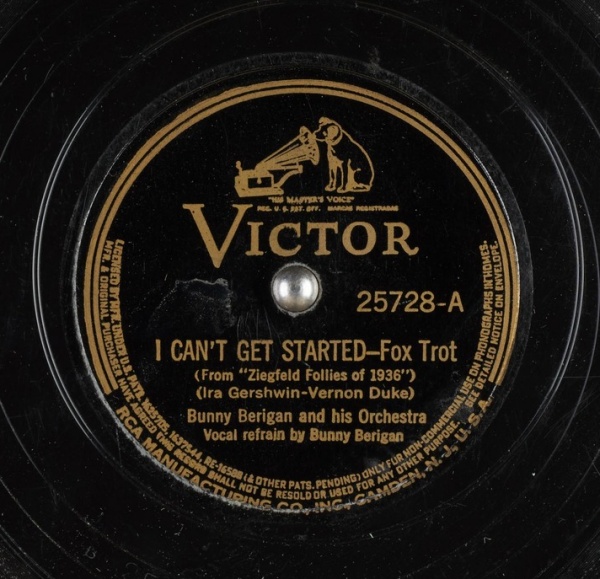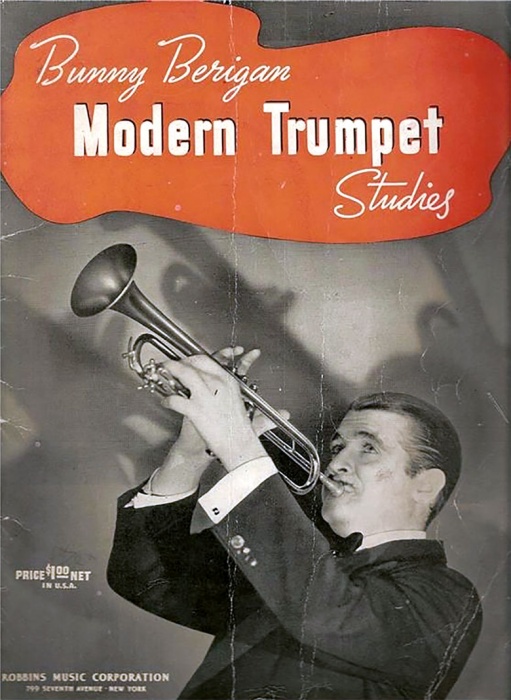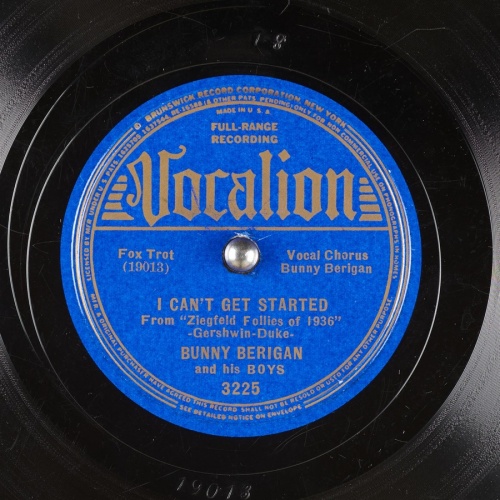I Can’t Get Started – Bunny On The Money

When I write about an old jazz record it is sometimes to feature a player and his instrument, sometimes about a song, sometimes about the band, and other times about a style of music. Today’s feature combines them all into what might be among the top five highly regarded recordings from the second half of the 1930s.

When featuring old jazz records, I seem to have gravitated into two fat spots from whence so many of them are found. There is that fertile and fascinating period of immediately after WWII when everything seemed up in the air and the musicians were probing new directions with great frequency. And there is that period that began in the mid 1920’s and ended with the very beginnings of the swing era which Benny Goodman finally succeeded in pushing from the fringes into the public conciousness.
Between those periods is generally considered the heyday of jazz-as-popular music where the big bands ruled and every listener was surrounded by an embarrassment of riches in touring live performances and on the radio dial in the era before broadcasters played the same records you got at home.
Most of the music from that time (which we will arbitrarily peg as 1936-1942) is marked by well-known bands who featured well-known musicians and whch recorded enough songs that it is hard to pick a representative selection. Today’s feature is the opposite.

Bunny Berrigan was certainly well-known in the mid 1930s as a trumpet player in some of the most popular bands out there. But he is not well known today and would be virtually forgotten but for a single record committed to wax under his own name in 1937 – I Can’t Get Started.
Roland Bernard Berigan was born in Wisconsin in 1908 and was smack in the middle of the bunch of jazzmen (they were all men then) who came of age before the swing era. He followed the normal trajectory of going from band to band, finally ending up in New York in the early 1930s where he did studio work for radio and rubbed elbows with the big names. By 1934-35 he had played trumpet in the pre-famous bands of Tommy Dorsey, Glenn Miller and then the hot new swing band of Benny Goodman just as it was bursting into superstardom.

In 1936 Berigan was putting together a band of his own and he included in his “band book” a not-terribly-distinguished tune written earlier that year called I Can’t Get Started. He recorded it on the Vocalion label in 1936 and it became his band’s theme song.
The following year he was recording for Victor with a new, larger group and re-worked the arrangement, setting to wax a record that would become a classic and the definitive version of the song. The Victor version ran nearly five minutes long and was released on a 12 inch disc – the kind normally reserved for classical recordings – instead of on the typical 10 inch record.
This record begins with a long trumpet introduction that “warms up” over four extended chords and has Bunny playing from some of the lowest possible notes on the horn up a full two octaves. Then he enters the first chorus with his bright but mellow trumpet (cornet, actually) taking the lead in front of the band. That band, by the way, is quite anonymous with nothing really outstanding about it beyond possibly the subtle-but-still-interesting drum work of George Wettling. This thing is all Bunny.
The second chorus is Berigan again, but this time on a vocal. It was not unusual for bandleaders to double as singers in the early days of the big bands, and a lot of them were far worse than Berigan. I have always loved the really tight vibrato in his voice, and the way his singing is more like an instrumental than a typical vocal treatment of the melody. He never strays from the melody, but he plays around at the edges of it quite a lot.

We must admire, for a moment, those elegant lyrics that Ira Gershwin added to Vernon Duke’s melody for a typical-for-the-time Broadway show. All at once clever and poignant, it conveys the story of a guy who is at the peak of fame and success but who still can’t get the girl. Many of the cultural references are going stale now, but they paint a picture of a younger and more attractive 1936 version of “The Most Interesting Man In The World” from the Dos Equis commercials.
This song was less than a decade removed from Lindburgh’s transatlantic flight and Admiral Richard Byrd’s expeditions to the Antarctic, and right in the middle of an ugly and intractable civil war in Spain. As one sought by the President (Franklin D. Roosevelt), a major movie studio (Metro-Goldwin-Mayer) and the famously reclusive Greta Garbo, the song’s pitiful protagonist has finally discovered the unattainable. Some of these cultural references were added by Bunny himself in place of the original Gershwin lines. Later singers have done some updates to the lyrics (Sinatra comes to mind) but these originals have a charm about them that adds to rather than detracts from a great jazz performance.
The record moves into an extended transition that mimics the opening, and then Berigan turns loose with a trumpet solo that is all at once lyrical, warm and soaring, finally ending on a literal high note as the band pops in for a little final background texture. Berigan had a phenominal range on the cornet, playing full and fat all the way from the sub-basement to the flagpole atop the penthouse. It has been written that Berigan’s playing was a world-expanding experience for those listening live.

The big band era generated a lot of vanilla ballads, usually arranged in a three-chorus pattern of band-vocal-band, most of them not really known for either great singing or more than individual nuggets of great playing. This one managed to both fit that pattern (band-vocal-band) and break it at the same time because of the stellar trumpet that is the star of this show and a gentle but still present swing under its languid tempo.
In his 1959 book Lyrics On Several Occasions, Ira Gershwin noted that sales of the sheet music for I Can’t Get Started had not amounted to much, but that this recording was the thing that put the song into the consciousness of generations of jazz players and listeners. Which is undoubtedly why this recording was inducted into the Grammy Hall of Fame in 1975. And it was also popular right out of the gate, something not always the case with records held in high esteem decades later.
But that was a long time ago and times have changed. Music from the late 30’s is not so hip now, particularly a long, sentimental ballad that features none of the pop and sizzle of the postwar music scene. If, however, you choose to take a listen, I believe that you will be drawn into this little drama of a man, a woman, and one of the most gifted trumpet players of his era.

Bunny Berigan finished his life the way so many of his generation and profession did – dead before the age of 35 from alcoholism and the kinds of hard living that go with it. And like most of them, his name has largely drifted out of public conciousness. Fortunately, he left us with a singular masterwork that stood out then and still does as one of the most brilliant recordings ever made.
Further reading: There is a wonderfully detailed piece on this recording at Mr Trumpet, a website devoted to Bunny Berigan
Media Credits
Victor Recording from August 7, 1937 from the youTube page of the78Prof.
Photo Credits
1938 photo of Berigan in front of his band from dagogo.com
Victor record label – from this record’s entry at The Internet Archive
Cover of Bunny Berigan trumpet method book from dagogo.com
1936 “I Can’t Get Started” Vocalion label – from that record’s entry at The Internet Archive
Bunny Berigan promotional poster from dagogo.com
Berigan’s MCA promotional photo – not copyrighted, found at Bunnyberiganmrtrumpet.com

At the risk of being shown the door by the bouncer, I’ll admit that I know this one from Barry Manilow in the mid ’90s.
Although the tempo is a little faster, the arrangement seems to follow Berigan and the video in YouTube includes what looks like footage of Berigan and his band.
LikeLiked by 1 person
Haha, we’ll let the Barry thing slide this once.
Seriously, it doesn’t surprise me that Barry’s treatment has a relationship to this one. I think this is one of the songs that had the definative version happen early on and it has been hard to escape Bunny’s shadow when anyone has done it in the decades since.
LikeLike
I liked it…..I even liked the lyrics…..tea with Greta Garbo!
LikeLiked by 1 person
Yes, that is one of my favorite lines too.
LikeLiked by 1 person
Styles fade away and eventually return, just like music genres … everything comes back for another turn at greatness. On second thought, as to style – there is the pencil-thin mustache, hair parted in the middle and the very wide lapels that Bunny Berigan is sporting. Maybe ALL styles don’t make a comeback after all.
LikeLiked by 1 person
Haha, I think the wide lapels and the hair have come back, though at different times and briefly. I don’t think the pencil mustache has, though.
LikeLiked by 1 person
I look back at the styles from high school and in our yearbooks the guys and gals all look alike – hair parted in the middle – no pencil mustache, unless it was the first one they were trying to grow and it was sparse. The clothes circa 1970 were pretty outlandish.
LikeLiked by 1 person
I’m a bit late to this party—but very glad I didn’t miss it. This was a super special listening experience. Thank you, as always, for the research you devote to placing these musical gems in context for us.
LikeLiked by 1 person
Thank you, glad you found something worthwhile in Bunny’s effort. I eventually decided that this one is a mini opera where the music amplifies a timeless story.
LikeLike
I’ll buy that.
LikeLike
You’re somewhere near my age, do you have any memory of Steve Martin using the first line of this song (“I’ve flown around the world in a plane”) in some kind of smarmy lounge singer skit in the late 70s? I’m sure I remember it but couldn’t find any clips on YouTube. Or maybe I’m imagining it.
LikeLike
Pingback: Rex Stewart Goes All Zaza – Which Is Good | J. P.'s Blog
Pingback: The (Original) Voice – Not A TV Show But The Young Band Singer, Frank Sinatra | J. P.'s Blog
Pingback: The Boswell Sisters (or How Three Little Girls From New Orleans Changed Popular Jazz Singing) | J. P.'s Blog
William B Williams on his show rated Berigan’s record number 1
LikeLiked by 1 person
Thanks for this bit of info!
LikeLike